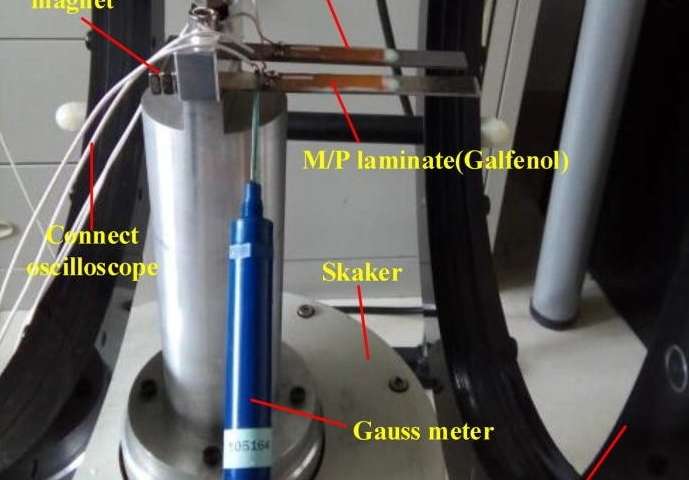Chinese researchers have demonstrated a novel hybrid device that is able to harvest energy from both mechanical vibrations and magnetic fields to generate electricity. Although the voltage output is small, it could potentially power devices with low-power requirements, such as wireless sensors or cardio pacemakers.

Image of the hybrid energy harvester developed by physicists at the Tsinghua University in Beijing. Credit: Xu et al.
There’s no such thing as a perfect power generation system, as energy will always be lost somewhere along the chain. For instance, a gasoline-powered internal combustion engine can’t hope to reach a thermal efficiency of more than 40%. This means that 60% of the chemical energy of the gasoline is lost along the way, primarily as heat.
Naturally, we’d like to get back as much of that energy as possible. Some promising ideas include regenerative brakes that charge batteries when el electric or hybrid car driver steps on the brake pedal, and highway wind turbines that capture energy from passing cars. There are even some nightclubs or walkways that capture energy from the vibrations generated by human footsteps.
However, while there are a wide range of devices that harvest either mechanical or magnetic energy, few power systems target both.
Because ambient mechanical and magnetic energy often appear in tandem in industrial settings — such as around rotating electrical machines — researchers at the Tsinghua University in Beijing wanted to find a way to harvest both types of energy.
The team led by Professor Fulei Chu showed theoretically and experimentally that mechanical and magnetic energy are “interactive” — when you combine the two, the optimal output power for each type of energy increases more than it would have been possible had one of the two been used alone.
According to their results, power output is heavily determined by whether or not the frequencies of the mechanical and magnetic waves are in sync, as well as by their amplitude. If the two frequencies have the same values, their phase difference (how much one wave is shifted with respect to the other) will affect the output voltage. However, if the two frequencies are different, then the phase difference makes little difference as far as the output voltage is concerned.
The optimal output power of the hybrid energy harvester can increase by 14.82% in respect to vibrations, and 30.40% when compared to magnetic excitations, the researchers reported in Applied Physics Letters.
To demonstrate their theoretical model, the researchers devised an experimental setup consisting of a cantilever beam made of a magnetostrictive/piezoelectric laminate material, which moves in response to both magnetic fields and vibrations.
“We have proposed the idea of taking advantage of two different energy harvester approaches and showing their interactions,” Chu told Phys.org. “As we know, energy harvesters have been investigated for decades and many methods are involved. However, each approach has its shortcomings. It is difficult and interesting to break through the single energy harvester limitations. Moreover, revealing the interactive relationship is important for the work as a whole.”
Chu believes that hybrid energy harvesting systems such as the one his group has demonstrated could lead to improvements in energy capacity and reliability for some applications, particularly the low-power electronics in the future. In the future, the Chinese researchers want to investigate whether such a hybrid energy harvesting approach is feasible for wind energy, wave energy, and other smart material applications.









